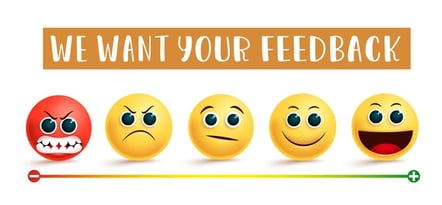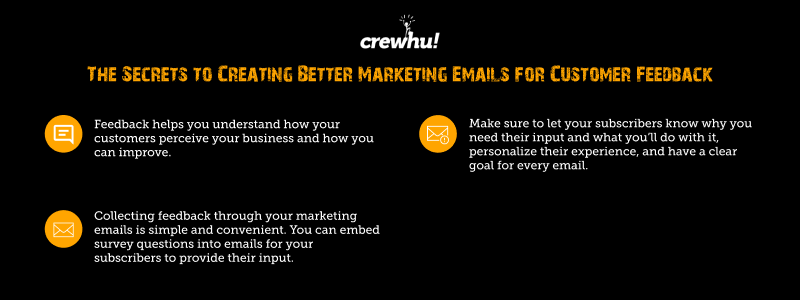The Secrets to Creating Better Marketing Emails for Customer Feedback


Every business owner knows that customer feedback is invaluable. After all, the best people to ask about your products or services are the ones using them.
Using email is a great way to collect qualitative feedback from your audience. Unfortunately, it isn’t always easy. Your customers are constantly bombarded with emails and social media notifications, making it difficult to grab their attention. But by employing best practices and engaging copywriting, you can break through the barrier and get the feedback you need. Here’s how.
Using marketing emails to collect feedback
Collecting feedback through email is a great way to find out how your target audience is perceiving your products and services. It also improves your customer-centricity. When you use your email campaigns to collect feedback, you create a two-way communication platform—your customers get the opportunity to share their thoughts and you learn what they value.
Embed survey questions into emails
Convenience is crucial if you want your readers to respond. And if you embed survey questions into your marketing emails, it takes only one click for your customer to respond. The most common way is by using Net Promoter Score (NPS) surveys. You’ve probably seen the question “How likely are you to recommend us to a friend or colleague” before. With one click, the reader can answer on a scale from 0 to 10.
Alternatively, you can use one-question surveys, which can range from yes/no to multiple-choice. One of the most effective ways is to ask a question with a list of answers that are all hyperlinks. When a reader chooses an answer by clicking any of the links, their response and email address are automatically captured.
Tips for creating better marketing emails to get feedback
The trick, of course, is to get your customers to open your email in the first place—and then get them to read it and respond to your prompts. As we said earlier, this isn’t always easy since their inboxes are full of emails from other companies vying for their attention. So how do you cut through the noise? Here are six simple strategies:
1. Create every email with a goal
Don’t clutter your marketing emails with multiple messages. Instead, establish one clear goal for each email, such as promoting a new product or service, then ask a question that supports that goal.
For instance, if a customer has made a successful purchase, you can send a post-purchase email to follow up on their experience. In such a case, asking the NPS survey question, “How likely are you to recommend us to a friend or colleague” would support your objective—to measure customer satisfaction.
2. Start your emails with a catchy subject line
Almost half of your email recipients will open your email based on the subject line. Since it’s the first thing they see, you’ll most likely lose them if you don’t hook them right away.
Keep your subject lines short and sweet, with a recommended optimal length of less than 45 characters. Other best practices for creating email subject lines that spark interest include:
- Use language that inspires readers to take action, such as “improve” and “buy.”
- Use trigger words that create a sense of urgency, arouse curiosity, appeal to vanity, reward sloth, etc.
- Create a value prop subject line that indicates what benefits or solutions you can offer to solve your readers’ problems
- Use emojis to keep your subject lines trendy
- Tap into the power of personalization by including the subscriber’s name
- A/B test your subject lines to find the one that works best
Ensure your subject line is relevant and related to the email body. No matter how enticing the subject line is, your readers will feel cheated if they open your email expecting one thing and get another.
3. Segment your subscribers
Segmenting your email list helps you target the right subscribers, making you more likely to generate engagement. After all, a prospect has different needs than a repeat customer, so using the same feedback email in both cases just doesn’t make sense.
Customer segmentation allows you to group and tag customers based on their shared characteristics, such as demographics, needs, purchase history, and behavior. For example, The North Face, an outerwear brand, segments its customers into lifestyle categories like “hiker,” “traveler,” and “explorer” and pushes relevant products to each segment.
4. Focus on personalization
Email personalization helps draw your customers in by creating deeper connections. It can also increase your open rates, which is critical to improving your response rates.
Look for opportunities to make the emails personal, such as incorporating the recipient’s name in the subject line and introduction. You can also include helpful advice tailored to their habits and personalize content offers, discounts, and product recommendations.
5. Keep your emails short, simple, and focused
Surveys with too many questions have a higher drop rate. The modern internet consumer has a short attention span and often scans and retrieves the information they consider important in an instant.
If your email has too much content or too many survey questions, the respondent will be more likely to skip over or leave the survey incomplete. Make sure your audience can provide a response with as little effort as possible by keeping your surveys short and sweet.
6. Tell your subscribers why you need their input and what you’ll do with it
It’s important to tell your subscribers why their input is important to you. Giving them the “why” also gives them an incentive to complete your survey.
For instance, suppose you provide a software-as-a-service platform. Telling subscribers that you want to get their thoughts on how to improve the product will motivate them to respond because they’ll have a say in the features that will be added to a tool they use.
Collecting quality customer feedback is important for the growth of your business. Just follow the six steps outlined above, and you’ll be well on your way. It can be a pretty time-consuming process, however, which is why working with a reliable partner to create surveys and capture feedback may ultimately be your best bet.
Collect valuable feedback with Crewhu
Crewhu makes it easy to collect feedback by sending automated NPS surveys, collecting Customer Satisfaction Scores (CSAT), and generating real-time reports and analytics to provide insights into what’s working in your business and what isn’t. It also easily integrates with your ticketing system, PSA, or email system to automate the feedback process.
Book a Crewhu demo today and let us show you how we can make it easy to capture your customers' feedback.






